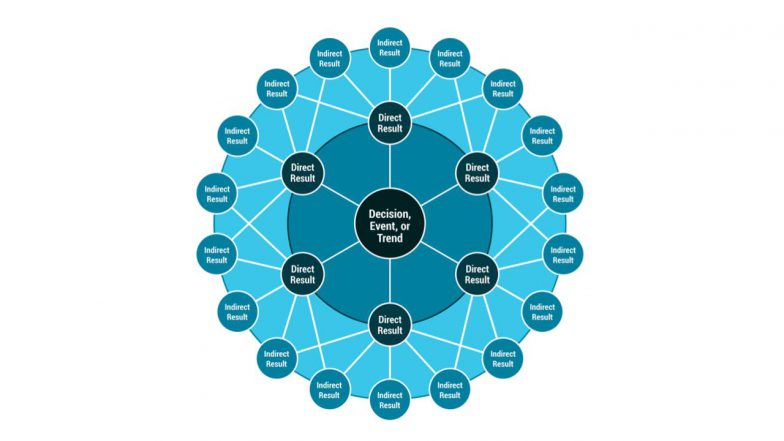Summary
The futures wheel is a method for graphical visualisation of direct and indirect future consequences of a particular change or development. It was invented by Jerome C. Glenn in 1971, when he was a student at the Antioch Graduate School of Education (now Antioch University New England).
The Futures Wheel is a way of organizing thinking and questioning about the future – a kind of structured brainstorming. (Jerome C. Glenn (1994) The Futures Wheel)
Source: Wikipedia
OnAir Post: Futures Wheel
About
Description
To start a futures wheel the central term describing the change to evaluate is positioned in the center of the page (or drawing area). Then, events or consequences following directly from that development are positioned around it. Next, the (indirect) consequences of the direct consequences are positioned around the first level consequences. The terms may be connected as nodes in a tree (or even a web). The levels will often be marked by concentric circles.
Usage
The futures wheel is usually used to organize thoughts about a future development or trend. With it, possible impacts can be collected and put down in a structured way. The use of interconnecting lines makes it possible to visualize interrelationships of the causes and resulting changes. Thus, futures wheels can assist in developing multi-concepts about possible future development by offering a futures-conscious perspective and aiding in the group brainstorming.
Web Links
Articles
Explore Direct & Indirect Consequences Using a Futures Wheel
Source: Medium – Matthew Stephens
A brainstorming exercise to consider the possible results of a particular decision, event, or trend.
If you’re like me, a typical day consists of a million tiny decisions that you’ve gotten really good at answering. “What should I eat for breakfast?” or “What Netflix show should I binge next?” But occasionally, there are some decisions that require more thought, either because they’re too complicated or just really important. Recently, I’ve found Jerome C Glenn’s “Futures Wheel” to be a helpful exercise when thinking through those situations. In Glenn’s own words, “the futures wheel offers ‘a kind of structured brainstorming’ about the future. We start with a root trend; then, in a ring around the trend, we write some of its potential consequences.”
As a visual thinker, it’s important for me to literally see my options laid out and how they’re all connected to each other. The simplicity and versatility of this exercise has really improved my ability to make better long-term decisions for everything from analyzing hiring practices to predicting how a product decision might unknowingly cause harm to others. I find it useful in my personal life, as well, when faced with important life decisions. Recently, I used it to help determine the risks of visiting my aging parents during COVID for their 50th anniversary. (I chose to seem them, but only after getting tested.)


